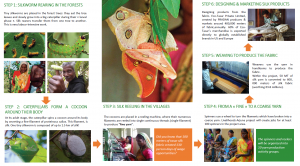With its natural sheen, light weight, soft touch and high durability, silk is considered as the most elegant textile in the world. There is a reason why they call it the “Queen of Textile”. But did you know that in India the production of natural silk, known as sericulture, was a central source of income for thousands of marginalized tribal communities? The Livelihoods Carbon Fund #2 is launching a high-scale agroforestry and silk-tree plantation project to couple reforestation, biodiveristy preservation and sustained livelihoods for thousands of tribal Adivasi communities.
With the plantation of 3, 000 hectares of Tasar silk trees in privately owned wastelands in the villages, Livelihoods-Arjuna project will generate income for 4, 000 rural households represented by women. The project also involves biodiversity preservation in 3, 600 additional forest hectares and will support 1, 200 households undertake silkworm rearing in host trees. Downstream, the project will create more than 5, 000 rural jobs for Adivasi inhabitants who will be involved at every step of Tasar silk value chain. Overall, the project will store 1.4 million tons of CO2 over 20 years, providing carbon offsets with strong environmental, economic, and social benefits to Livelihoods investors and partner companies. It will also contribute to restore soil health and preserve water resources.
The project will be implemented by the reputed Indian NGO PRADAN which has been working committedly in the poorest regions of India, for more than three decades, to help vulnerable communities, especially women, earn a decent living and support their families. The NGO has put in place a robust economic model to generate income for Adivasis farmers, at every step of the silk value chain.
Tasar sericulture : an income opportunity for forest-dwellers Adivasi communities
Adivasi are considered as the indigenous population of India. Their livelihoods mostly depend on the land they cultivate, and the forests they live nearby. Livelihoods is already working closely with Adivasi communities: both Livelihoods-ARAKU projects have helped these marginalized communities generate a sustainable income thanks to the production of high-quality organic coffee, ARAKU, while preserving their forest, in Araku valley.
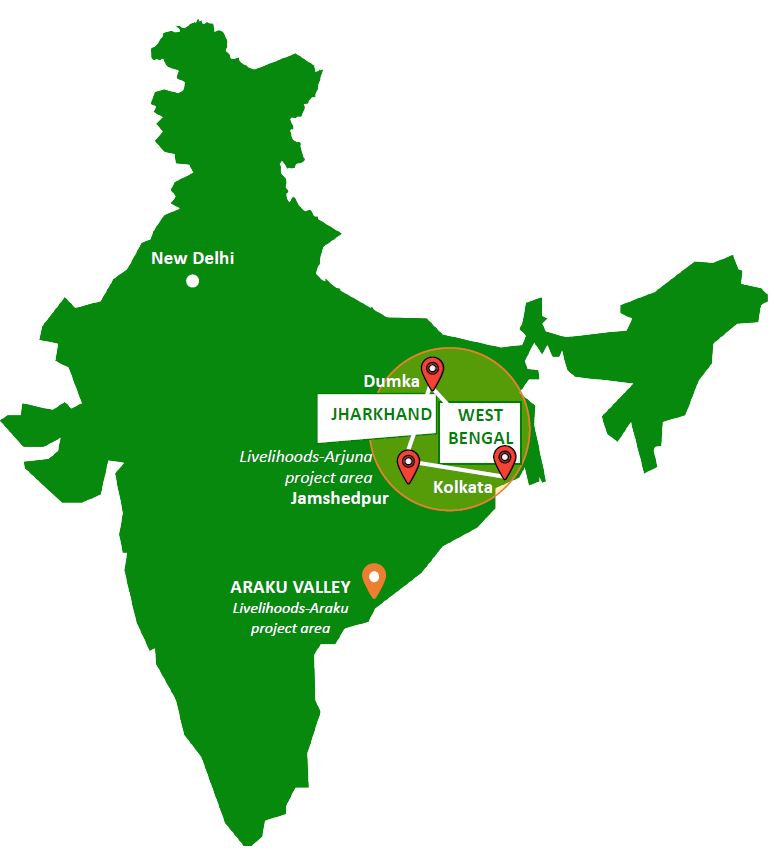
This time, Livelihoods-Arjuna project will support Adivasi communities couple forest preservation with improved livelihoods, thanks to the production of Tasar silk. The project will be implemented in the plateau region of Eastern India, in the states of Jharkhand and West Bengal, 300 kilometres from Kolkata city. Among the five varieties of silk that are produced in India: mulberry, eri, muga, Tasar, oak Tasar silk, Tasar silk is a wild silk; its production starts with outdoor silkworm rearing. And it is an ancient tradition of Adivasis, initiated in the 15th century, which reflects their strong connection with the forests. But until 30 years ago, Tasar silk rearing had become an unreliable source of income as natural diseases and rudimentary methods led to uncertain yields.
The farmers, who practiced Tasar sericulture as a complementery source of income to agriculture, had slowly abandoned silkworm rearing.
Livelihoods partners with PRADAN NGO to build on a robust Tasar silk value chain with women at the forefront
With a strong focus on empowering rural communities with key economic opportunities, PRADAN has established a robust scientific, technical, and economic model to revamp the whole Tasar silk value chain and create job opportunities from silkworm rearing in the forests to the international commercialization of silk fabric.
PRADAN’s initial challenge was to revive an entire sector that was mostly controlled at government level, with the ambition to bring economic opportunities for Adivasi tribes at every step of Tasar silk value chain. PRADAN’s model for Tasar sericulture relies on:
1. GOOD-QUALITY SEED EGGS FOR SILKWORM REARERS IN THE VILLAGES:
Until thirty years ago, the supply of good quality seed eggs (called Disease Free Layings) was managed at Government level. There were no quality norms for forest silkworm rearing, thus impacting silkworm rearers’ income. PRADAN has developed a private Tasar seed production system so that Adivasi silk rearers could access good quality seed eggs and avoid crop losses. Today, PRADAN has put in place village-based private enterprises, called “grainage” where good quality seed eggs are produced and made available at the doorsteps of rearers. Eleven seed production units in 352 villages now produce 1.5 million disease free layings, annually.
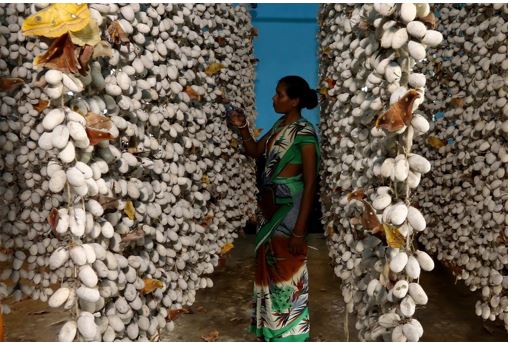
Private grainages in the villages produce disease-free layings which are necessary to ensure the commercialization of healthy cocoons, from which the silk is later extracted.
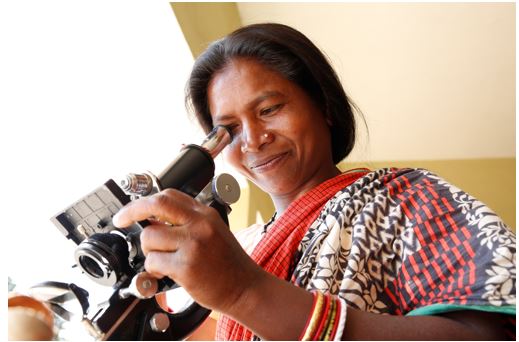
Each female moth that lays eggs is examined individually under microscopes to ensure disease-free layings.
2. HIGH-QUALITY COCOON PRODUCTION IN THE FORESTS:
The second step of tasar sericulture in the production of cocoons in the forests. The silkworms eat leaves from the host trees and slowly form a cocoon around their body. These trees need to be managed efficiently and planted at a certain distance, to make sure the silkworms have enough space to form the cocoon, from wich the silk yarn is later extracted. PRADAN has empowered silk rearers with pruning and rearing techniques so that coocoons grow correclty. Influencing the Forest Department to provide forest access to Adivasis thus helping them preserve the forests was also one of the pioneering actions from PRADAN.
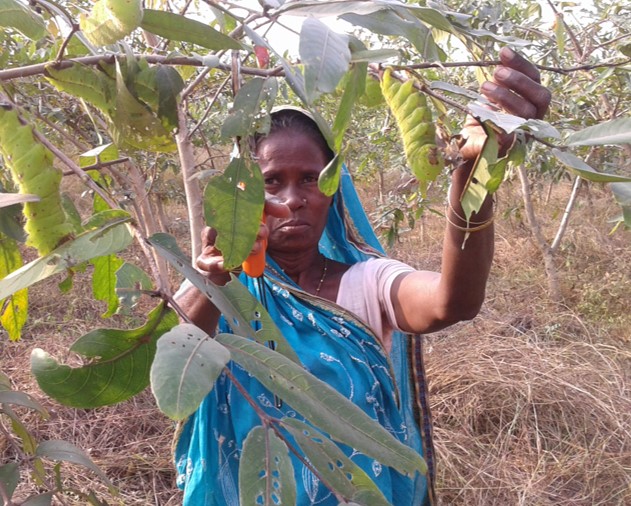
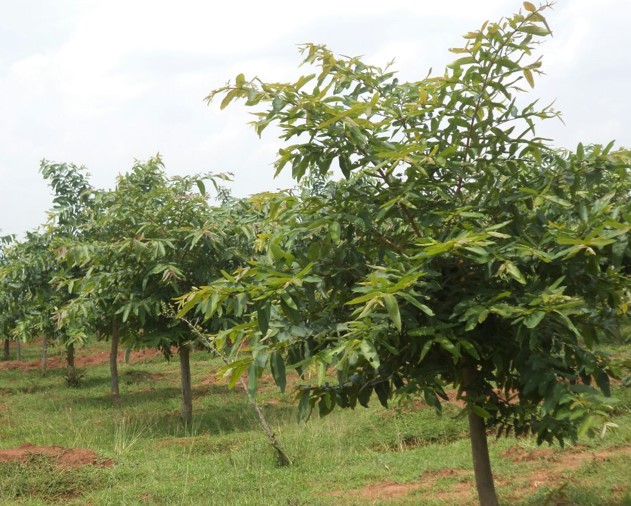
The silkworms are placed in the trees so that they can eat the leaves and go through their transformation phase: grow from a tiny silkworm to a beautiful caterpillar. They are placed in other host trees when they have eaten all leaves of the first tree.
3. AN EFFICIENT VALUE CHAIN TO ENSURE CONSTANT SUPPLY OF SILK TO THE MARKET:
PRADAN has worked with private and public agencies to put the right technical skills and manpower for reeling and spining silk and also ensure good quality and enough quantity of yarn was available in the market. PRADAN has put in place a yarn production technology and equipped Adivasi rural communitites with spinning and reeling machines to earn a living from Tasar yarn production all round the year. Today, 530 Adivasi women are involved in the spinning and reeling activities. When traditional methods implied that women needed to use palm and thigh to reel and spin the yarn, today, reeling machines help them achieve better productivity, beyond being safer for them.
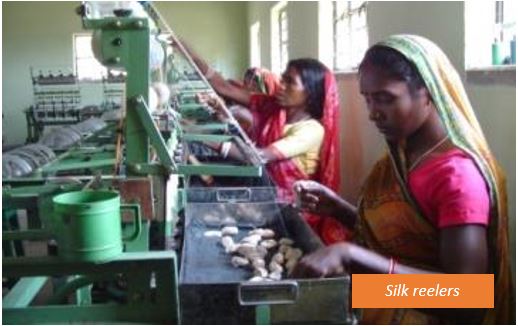
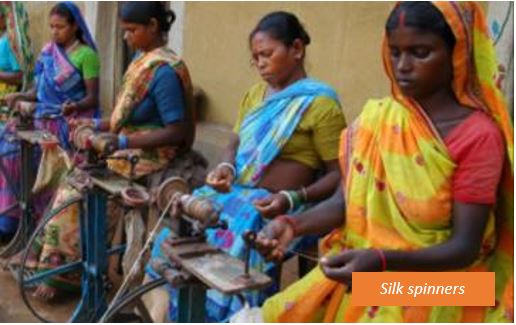
4. CREATE A STEADY MARKET OF TASAR CUSTOMERS:
PRADAN has also developed the commercialisation of Tasar silk by intervening in the processing, designing and marketing of Tasar silk products. Two decades ago, there were no quality and pricing standards in the villages, but today, PRADAN works with buying houses and fabric exporters to support the marketing of bulk volumes of silk yarn. PRADAN has created Eco-Tasar Private Limited brand to provide and promote Tasar silk yarn. It also integrates weaving and fabric marketing activities in its value chain and employs weavers, stitchers, finishers, printers.
Livelihoods-Arjuna project will couple reforestation, biodiversity preservation and improved livelihoods for Adivasis communities
Tasar silkworms are the backbone and the first step of Tasar sericulture. They eat leaves of two different species: Terminalia arjuna & Terminalia tomentosa, which help them grow and turn from a tiny silkworm to a beautiful green caterpillar.
The Livelihoods Carbon Fund is financing the plantation of 3, 000 hectares of Terminalia arjuna & Terminalia tomentosa host trees, in wastelands that had previously been depleted. These wastelands belong to 4, 000 households represented by women. Both types of trees are fast-growing, local to the project area and will be ready for silkworm rearing in 3 years from now. Adivasi communities will be mobilized into groups to set up the planting activities and tree maintenance, as they grow. These communities will be involved and empowered with scientific and technical skills to evaluate the right distance from one tree to another, to help the cocoons grow correctly and ensure their good productivity. Overall, the 3, 000 hectares of trees will also sequestrate 1.3 million tons of CO2, during the entire lifespan of the project (20 years).
The project will also support 1,200 households to undertake silkworm rearing in 3,600 additional hectares of forests. This part of the project will be ensured by village communities: in compliance with community norms in the villages, the project will therefore protect biodiversity in 3, 600 hectares, by ensuring the diversity of tree species. 1, 200 households as well as the corresponding village committees will be trained in biodiversity conservation.
Create more than 5,000 rural jobs in a context of high export & domestic Tasar silk demand
The plantation of 3, 000 hectares of Tasar silk host trees is the primary asset on which the income generation activities are being planned: the development of economic opportunities will be co-financed by PRADAN and its partners. The social and economic benefits from the project will motivate Adivasi tribes and marginal communities protect their plantations during the whole duration of the project.
Downstream, both the 3,000 hectares restored and the forest rearing will help produce 45 million cocoons that will be converted into 50 metric tonnes of raw silk. 1,500 yarn producers will be involved to work year-round and covert the raw yarn produced within the project activities to silk yarn. The project will create job opportunities for 150 reelers (who will produce fine yarn) and more than 100 spinners to extract coarse yarn. The silk yarn (50MT) will be converted into 600,000 meters of silk fabric, thus also generating income for handloom weavers.
Livelihoods-Arjuna project will couple reforestation, biodiversity preservation and improved livelihoods for Adivasis communities
Tasar silkworms are the backbone and the first step of tasar sericulture. They eat leaves of two different species: Terminalia arjuna & terminalia tomentosa, which will help them grow and turn from a tiny silkworm to a beautiful green caterpillar.
The Livelihoods Carbon Fund is financing the plantation of 3, 000 hectares of Terminalia arjuna & terminalia tomentosa host trees, in wastelands that had previously been depleted. These wastelands belong to 4, 000 households represented by women. Both types of trees are fast-growing, local to the project area and will be ready for silkworm rearing in 3 years from now. Adivasis communities will be mobilized into groups to set up the planting activities and trees maintenance, as they grow. These communities will be involved and empowered with scientific and technical skills to evaluate the right distance from one tree to another, to help the cocoons grow correctly and ensure their good productivity. Overall, the 3, 000 hectares of trees will also sequestrate 1.3 million tons of CO2, during the entire lifespan of the project (20 years).
The project will also support 1,200 households to undertake silkworm rearing in 3,600 additional hectares of forests. This part of the project will be ensured by village communities: in compliance with community norms in the villages, the project will therefore protect biodiversity in 3, 600 hectares, by ensuring the diversity of tree species. 1, 200 households as well as the corresponding village committees will be trained in biodiversity conservation.
Create more than 5,000 rural jobs in a context of high export & domestic tasar silk demand
The plantation of 3, 000 hectares of Tasar silk host trees is the primary asset on which the income generation activities are being planned: the development of economic opportunities will be co-financed by PRADAN and its partners. The social and economic benefits from the project will motivate Adivasi tribes and marginal communities protect their plantations during the whole duration of the project.
Downstream, both the 3,000 hectares restored and the forest rearing in the forest will help produce 45 million cocoons that will be converted into 50 metric tonnes of raw silk. 1,500 yarn producers will be involved to work year-round and covert the raw yarn produced within the project activities to silk yarn. The project will create job opportunities for 150 reelers (who will produce fine yarn) and more than 100 spinners to extract coarse yarn. The silk yarn (50MT) will be converted into 600,000 meters of silk fabric, thus also generating income for handloom weavers.
From the forest to a commercialized silk fabric:
THE 6 STEPS OF TASAR SILK PRODUCTION
Sericulture, or the production of raw silk is an incredible story of transformation and an outstanding source of income for Adivasi communities. But how does sericulture exactly work? Here are the 6 transformation steps from a tiny silkworm, to the final, died, and soft fabric:
DID YOU KNOW?
TASAR SILK RIDES ON A HIGH EXPORT & DOMESTIC DEMAND IN INDIA
Conventionally, Tasar silk and fabric were sold in original beige colour as plain fabric and bought by a limited group of connoisseurs. In the past two decades, there have been efforts made to develop Tasar fabric with innovative use of colour and weave textures. Today, Tasar is attractive to a large group of young costumers. Tasar silk is majoritely exported to the US, Germany, UK, France, Japan, UAE and Qatar.
Photo credits: Pradan/Eco Tasar



